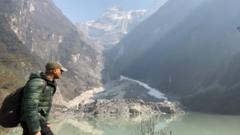Trekking in Nepal's Annapurna region, the majestic Himalayas have become significantly harder to see, veiled by thick haze attributed to worsening air pollution. Growing up in Kathmandu, I often marveled at the panoramic views of these iconic peaks. However, repeated visits reveal a disheartening reality—spectacular sights of the mountains have largely vanished.
This persistent haze now blankets the region regardless of the season, even during traditionally clear spring and autumn months. My recent flight into Kathmandu had to circle for nearly 20 times due to low visibility, a jarring reminder of how severe air pollution has affected this once-pristine region. Despite staying at a hotel with a good vantage point, my two-week visit yielded little more than an obscured view of haze.
Yogendra Shakya, a hotel operator in Nagarkot since 1996, expressed disappointment over the diminishing views. “I’ve rebranded my offerings to highlight history and culture instead,” he explained, as mountains have all but vanished from his promotional material. Last year, when trekking in the Annapurna region, I encountered the same frustration—hopes of gazing upon towering peaks were met with thick veils of haziness.
Experts note that these hazy conditions are becoming more prolonged and intense, often resulting from a combination of smoke, dust, and pollutants lingering in the air. Climate change exacerbates the issue, lengthening the dry season, which now often stretches into months when visibility should be at its best. Once ideal trekking months like March to May are increasingly robbed of their clarity.
In the industry, the fallout is severe. “Hazy conditions have resulted in a staggering 40% drop in business,” said Lucky Chhetri, a leading female trekking guide. A recurring sentiment among tourists is disappointment, as one visitor described his recent trip as “a major let-down,” noting stark differences from past visits.
The Trekking Agents Association of Nepal's chairperson Krishna KC voiced the looming crisis within the industry. “Our guides and trekking operators are discouraged because a lack of mountain sighting translates to no business—many are considering abandoning the profession altogether.”
On the Indian side of the Himalayas, haze conditions have worsened quicker than before, as stated by Malika Virdi, head of a community-run tourism business. However, she noted that persistent tourists often return for a chance to see the elusive mountains. Meanwhile, in Pakistan, haziness is creeping further, affecting visibility even in areas traditionally sheltered from pollution.
South Asia consistently ranks as one of the world's most polluted regions, leaving public health at risk. Major contributors to this air pollution include emissions from vehicles and industries, as well as agricultural practices that harm the environment. The increasing prevalence of hazes and dust storms is a troubling sign of changing climate patterns, according to experts.
As reported, 2024 saw 168 hazy days at Pokhara Airport—a stark increase from just 23 days in 2020. The Himalayas, probably one of the most affected mountain ranges globally, may soon only be visible through photographs and artworks.
“It feels guilty to sell an experience where we can’t deliver what clients expect—viewing the mountains,” reflected Lucky Chhetri, with little hope for resolution in sight as haze continues to blanket this natural wonder.


















